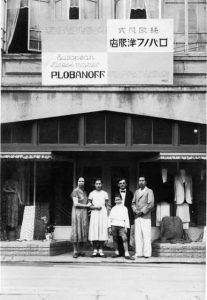@13 days until Hiroshima Summit: White Russians
May 6, 2023
by Kyoko Niiyama, Staff Writer
Some “White Russians” lived in the pre-bombed city of Hiroshima after they had been against Russian Revolution in 1917 and found asylum in Japan. Of them, it is said thirteen persons of six families experienced the atomic bomb, and five of them passed away by autumn of 1945.
Paul Lobanoff had a family of five and ran a clothing shop called “Lobanoff clothing shop in authentic European style” near the present-day intersection at Kamiya-cho (Naka Ward, Hiroshima). Whereabouts of the whole Lobanoff family, including their life and death, have not been confirmed since the bombing.
Sergei Palchikoff, a former music teacher at a girls’ school, experienced the atomic bombing in what is now Ushita-asahi in Higashi Ward. Mr. Palchikoff’s A-bombed violin, which he had cherished, is now displayed in the history museum at Hiroshima Jogakuin University (Higashi Ward), and sometimes played to deliver a melody of peace to the audience.
(Originally published on May 6, 2023)
Some “White Russians” lived in the pre-bombed city of Hiroshima after they had been against Russian Revolution in 1917 and found asylum in Japan. Of them, it is said thirteen persons of six families experienced the atomic bomb, and five of them passed away by autumn of 1945.
Paul Lobanoff had a family of five and ran a clothing shop called “Lobanoff clothing shop in authentic European style” near the present-day intersection at Kamiya-cho (Naka Ward, Hiroshima). Whereabouts of the whole Lobanoff family, including their life and death, have not been confirmed since the bombing.
Sergei Palchikoff, a former music teacher at a girls’ school, experienced the atomic bombing in what is now Ushita-asahi in Higashi Ward. Mr. Palchikoff’s A-bombed violin, which he had cherished, is now displayed in the history museum at Hiroshima Jogakuin University (Higashi Ward), and sometimes played to deliver a melody of peace to the audience.
(Originally published on May 6, 2023)








